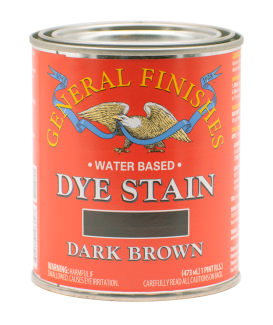

First, test your surface to get a sense for the color present in the wood. To do this, wipe the surface down with mineral spirits (if you are expecting to use an oil finish) or plain water (if you are expecting to use a water based finish). See the following GF video demonstration for a better understanding of this process.
Next, apply product. Here are two recipes for a lightly stained look:
A primer is your best defense under light-colored paint.
Another technique to avoid the slight color change that sometimes occurs when applying topcoat is to add 10-15% of the paint you are using to your topcoat. This technique layers additional coats of color over your piece as well as providing the protection of a topcoat. If you don't like measuring, just add enough paint until you can see a bit of the hue in the topcoat. This method works with a brush or a spray gun.
To maintain the full-strength protection of the topcoat, DO NOT TINT YOUR FINAL COAT of topcoat.
All bright white paint will yellow slightly with time, even without topcoat. You have probably tried to touch up white woodwork in your home after several years and noticed that the new paint is brighter.
But white and light paints can react if clear coated with a waterbased finish; water-based topcoats are reactive and may draw out substances in the wood such as tannins, dyes or unknown substances in existing finishes causing the topcoat to yellow. This is an industry-wide issue and can happen right away, years later or never.
Douglas Fir is a difficult wood to stain evenly. A 50|50 mix of your Exterior 450 stain color and Exterior 450 Clear would be a better choice for an exterior conditioner. Blotching may still occur even with this procedure.
After applying the conditioner mix, let it dry 2-3 hours. Allow more time in humid weather. Then a apply the stain color of your choice. Multiple coats will deepen the color.

Toning is the process of adding colorant, either dye or pigmented stain into a top coat and then applying over an entire piece in order to subtly deepen the color. All of our stains can be used: Stock base colors of RTM, Water-Based Wood Stains or Dye stains. If you are new to toning, we recommend starting with Dyes stains, which can be easier to use as they only contain dyes and no pigments.
Our recommendation to fix white cabinets that have yellowed is to do a thorough sanding and precleaning and recoat with the following products:
We all know that steam spots can come as the result of hosting holiday celebrations! But how does GF recommend dealing with the mark?
Traditionally, flat topcoats were created by adding matting agents to gloss topcoat. These agents decreased the durability of the topcoat and produced a slight haze that reduced the vibrancy of an underlying stain or paint.
Using newly patented polymer resin technology, matting agents are no longer required. Our new Dead Flat topcoats produce a brilliant clear finish while providing significant improvements to chemical, water and mar resistance.
It's always possible to darken a stained surface, but you cannot lighten a stained surface after the finish has dried.
When the surface is still wet, you can try to lighten the color by scrubbing with mineral spirits. If the finish has hardened, you will need to sand down your current stain and start over or use one of our paints.
You can mix GF Gel Stain colors to create a custom color.
You can also thin Gel Stain with 10-15% mineral spirits.
Always test our color on a hidden area of your project before beginning.
General Finishes is excited to present our April 2016 Blogger of the Month, DeDe Bailey of Designed Decor!